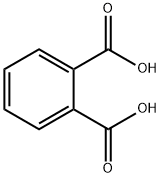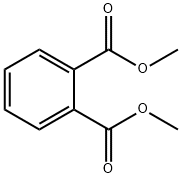Phthalate , standardforGC,≥99.5%(GC) , 88-99-3
Synonym(s):
1,2-Benzenedicarboxylic acid;Benzene-1,2-dicarboxylic acid;Phthalic acid
CAS NO.:88-99-3
Empirical Formula: C8H6O4
Molecular Weight: 166.13
MDL number: MFCD00002467
EINECS: 201-873-2
| Pack Size | Price | Stock | Quantity |
| 5G | RMB32.00 | In Stock |
|
| others | Enquire |
PRODUCT Properties
| Melting point: | 210-211 °C (dec.) (lit.) |
| Boiling point: | 214.32°C (rough estimate) |
| Density | 1.59 g/cm3 at 15 °C |
| bulk density | 960kg/m3 |
| vapor pressure | 7.8 hPa (191 °C) |
| refractive index | 1.5100 (estimate) |
| Flash point: | 168 °C |
| storage temp. | Store below +30°C. |
| solubility | methanol: 0.1 g/mL, clear |
| form | Powder |
| pka | 2.89(at 25℃) |
| color | White |
| PH | 3.2(1 mM solution);2.55(10 mM solution);2(100 mM solution); |
| Water Solubility | 7 g/L (25 ºC) |
| Merck | 14,7371 |
| BRN | 608199 |
| Dielectric constant | 5.1(Ambient) |
| Stability: | Stable. Combustible. Incompatible with strong oxidizing agents. |
| InChIKey | XNGIFLGASWRNHJ-UHFFFAOYSA-N |
| LogP | 0.73 at 20℃ |
| CAS DataBase Reference | 88-99-3(CAS DataBase Reference) |
| NIST Chemistry Reference | 1,2-Benzenedicarboxylic acid(88-99-3) |
| EPA Substance Registry System | Phthalic acid (88-99-3) |
Description and Uses
Phthalic acid is an aromatic dicarboxylic acid, with formula C6H4(CO2H)2. It is an isomer of isophthalic acid and terephthalic acid. Although phthalic acid is of modest commercial importance, the closely related derivative phthalic anhydride is a commodity chemical produced on a large scale.
It is a dibasic acid, with pKa's of 2.89 and 5.51. The mono potassium salt, potassium hydrogen phthalate is a standard acid in analytical chemistry. Typically phthalate esters are prepared from the widely available phthalic anhydride. Reduction of phthalic acid with sodium amalgam in the presence of water gives the 1,3- cyclohexadiene derivative.
Safety
| Symbol(GHS) |  GHS07 |
| Signal word | Warning |
| Hazard statements | H315-H319-H335 |
| Precautionary statements | P261-P264-P271-P280-P302+P352-P305+P351+P338 |
| Hazard Codes | Xi |
| Risk Statements | 36/37/38 |
| Safety Statements | 26-36-37/39 |
| WGK Germany | 1 |
| RTECS | TH9625000 |
| TSCA | Yes |
| HS Code | 29173980 |
| Hazardous Substances Data | 88-99-3(Hazardous Substances Data) |
| Toxicity | LD50 orally in rats: 7.9 g/kg (Shaffer) |


